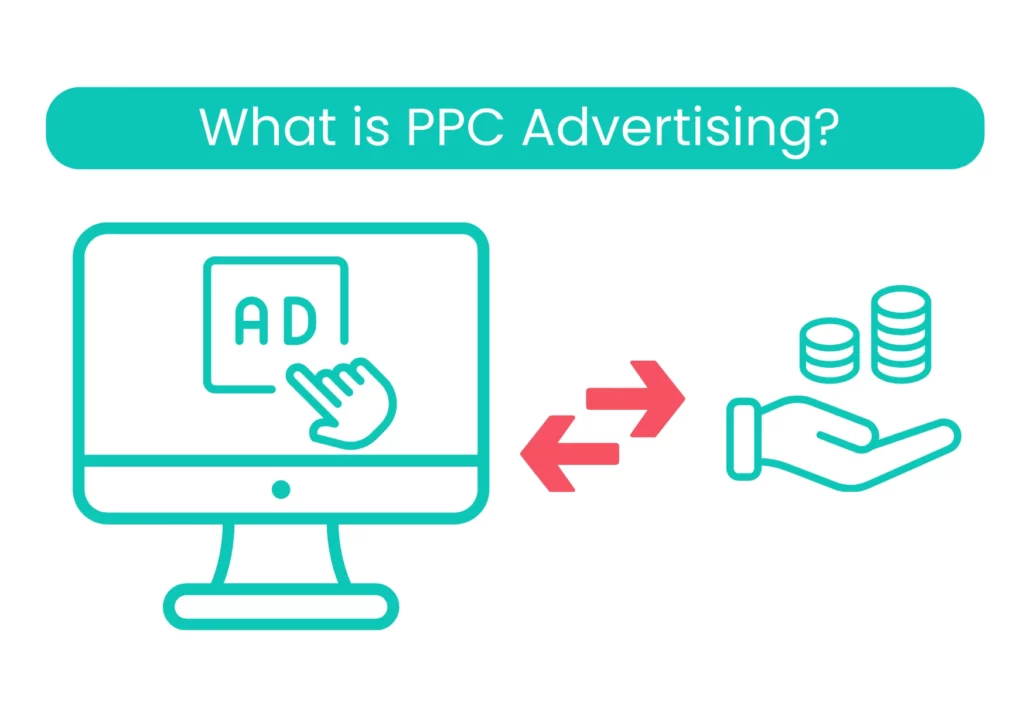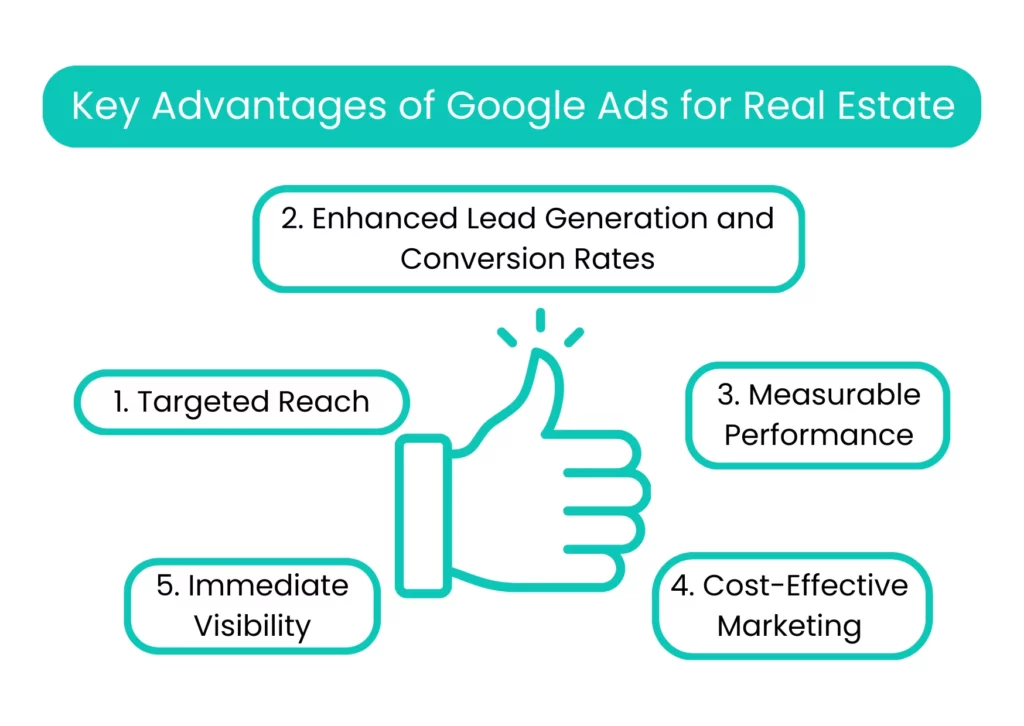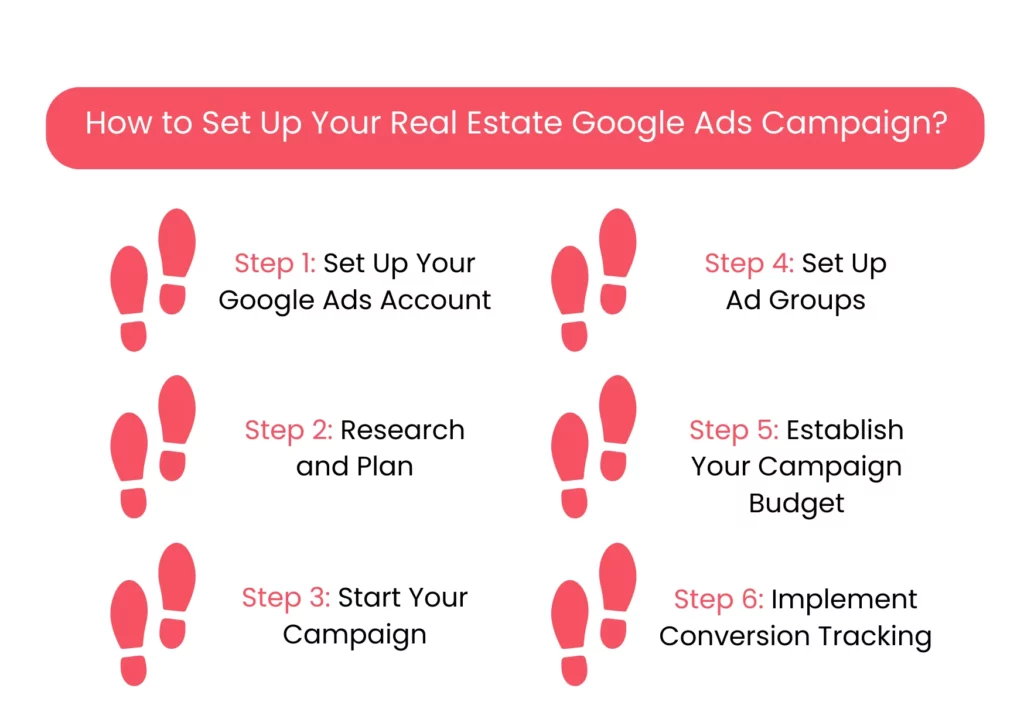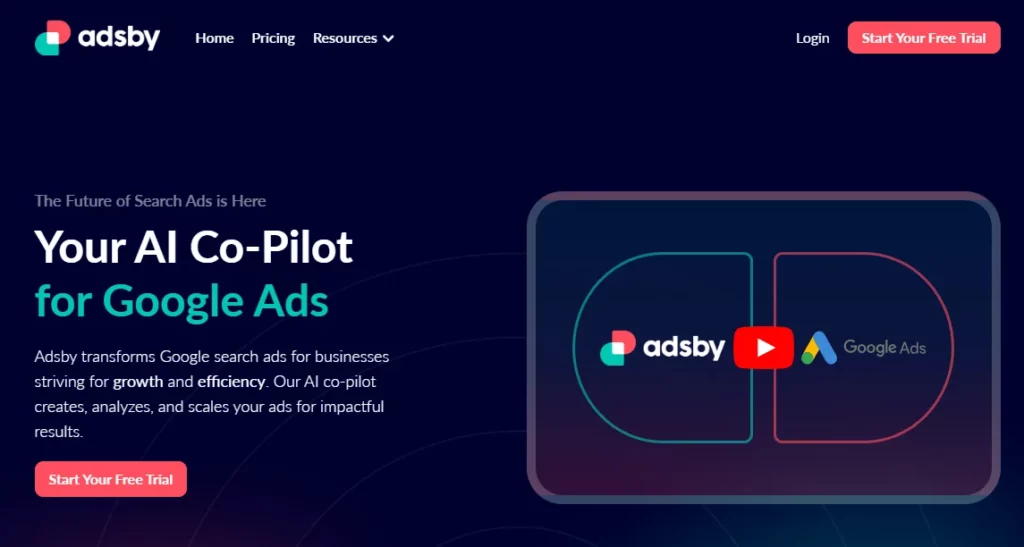
Google Search Ads have become a must-have tool for real estate professionals looking to attract high-quality leads and grow their business. These ads are carefully designed to show up when potential clients search for related properties or services, giving your marketing efforts a big boost.
Targeted Google Search Ads let you reach people who are actively looking for real estate solutions. By focusing on specific keywords and groups of people, you can connect with potential buyers and sellers more effectively. This approach not only makes the most of your ad budget but also ensures that your message reaches those who are most likely to be interested in your services.
In this guide, we will take you step-by-step through the entire process of setting up a Google Ads campaign. This will help you boost your real estate business’s visibility and connect with more customers. Before we dive into the step-by-step process, let’s look at some basic definitions.
Table of contents
What is PPC Advertising?

PPC, or pay-per-click, is an online advertising model where advertisers pay whenever a user clicks on one of their ads.
There are various types of PPC ads, but one of the most common is the paid search ad. These ads show up when people search for things online using search engines like Google, especially during commercial searches, which means they are looking to buy something. This could range from a mobile search (like someone searching for “pizza near me” on their phone) to a local service search (such as someone looking for a dentist or plumber nearby) to someone shopping for a gift (“Mother’s Day flowers”) or an expensive item like enterprise software. All these searches can trigger pay-per-click ads.
In pay-per-click advertising, businesses running ads are only charged when a user clicks on their ad, which is why it’s called “pay-per-click.” Other types of PPC advertising include display advertising (usually involving banner ads) and remarketing.
What is Google Ads?
Google Ads is the name of Google’s pay-per-click (PPC) platform, which enables businesses to increase their visibility across Google’s properties. The most common type of Google Ads ad is the search ad, which shows up on the search engine results page (SERP) for searches related to the advertiser’s products and services.
However, businesses also use Google Ads to run display ads, shopping ads, YouTube ads, and more. These ads help businesses reach potential customers in different ways, whether through videos, product images, or direct search results.
How Google Real Estate Ads Operate?
Before delving into the setup of your Google Ads account, it’s crucial to grasp the fundamentals of how it functions. Google Ads operates on a pay-per-click (PPC) model, where businesses bid on keywords relevant to their offerings.
When a user searches on Google, the system evaluates advertisers based on their bids and other factors like the quality and relevance of their keywords and ads. It then selects a set of ‘winners’ whose ads will appear in the ad space on the search results page. This selection process ensures that ads shown are highly relevant to the user’s search intent and provide value to both the advertiser and the searcher.
Key Advantages of Google Ads for Real Estate

1. Targeted Reach
Unlike traditional advertising methods, Google Ads enables you to pinpoint your ideal audience with exceptional accuracy. You can specify demographics such as age, income, location, and interests related to property preferences. This ensures that your ads are displayed to highly relevant users actively seeking properties that match your listings.
2. Enhanced Lead Generation and Conversion Rates
By placing your listings in front of the right audience, Google Ads drives more qualified leads and boosts conversion rates. When users actively search for properties and encounter your targeted ads, they are more inclined to engage with your listings and reach out to learn more.
3. Measurable Performance
Unlike traditional media like billboards or print ads, Google Ads provides robust tools to track essential metrics such as impressions, clicks, website visits, and lead form submissions. This data allows you to precisely gauge the effectiveness of your ad campaigns and refine them for optimal performance. For instance, tracking website form submissions helps identify which ad variations and keywords generate the most leads for your specific listings.
4. Cost-Effective Marketing
Compared to conventional advertising avenues, Google Ads offers a highly cost-effective approach to reaching new clients. You set a daily budget and only incur costs when someone clicks on your ad. This level of control enables you to manage your expenditures effectively and maximize your return on investment (ROI).
5. Immediate Visibility
While SEO strategies require time to achieve significant results, Google Ads provides immediate visibility in search engine results pages (SERPs). Launching a Google Ads campaign positions your real estate listings prominently at the top of search results for relevant keywords, ensuring instant visibility to potential buyers.
How to Set Up Your Real Estate Google Ads Campaign?

Let’s set up and launch your Google Ads campaign step by step for your real estate business.
Step 1: Set Up Your Google Ads Account
Before diving in, ensure you have a Google Ads account ready. Your Google Ads account is where you’ll manage essential aspects like billing, administrative permissions, and your campaigns. Campaigns contain your ad groups, where you’ll allocate your budget and define your targeting. Each ad group will target a specific segment of your business with a unique set of keywords. Within these ad groups, you’ll create ads that will appear when users search for your specified keywords.
Step 2: Research and Plan
After setting up your Google Ads account, it’s time to focus on the areas your business covers and identify your ideal customers. Create a list of five to seven locations or niches you want to target. These will form the basis of your ad groups. For instance, if you’re based in San Diego, you might consider these ad groups: Downtown San Diego, La Jolla, Pacific Beach, Del Mar, Carlsbad, Encinitas.
Once you’ve pinpointed your target locations, move on to keyword research. Utilize tools like the Adsby Free Keyword Tool to understand the search volume, competition, and potential costs associated with various keywords. This tool may also provide you with keyword ideas you hadn’t previously considered, revealing high-volume search terms that potential clients use to find properties and services similar to yours. With your five to seven target areas or niches identified, you’re ready to start your campaign.
Step 3: Start Your Campaign
When you’re logged into your Google Ads account, click the blue plus sign to begin creating a campaign.
1. Select the Right Campaign Objective and Type
The first step is to choose a campaign objective that aligns with your goals. For real estate purposes, we typically recommend the “Website traffic” objective since the goal is usually to drive visitors to your website.
Here’s a brief overview of different campaign objectives:
- Sales: Focuses on boosting sales and profitability. Includes bidding strategies geared towards clicks, assets, and ads that prompt the purchasing or conversion process.
- Leads: Aims to generate leads by capturing customers’ information through form submissions.
- Website traffic: Prioritizes driving traffic and conversions to your website.
- Brand awareness: Enhances the visibility and recognition of your brand, not necessarily increasing website visits or leads.
- App installs and engagement: Designed for promoting app installs and increasing user engagement with a mobile application.
- Local store visits: Drives foot traffic to physical stores and increases offline sales.
- Product and brand consideration: Focused on increasing visibility and recognition of your brand to new customers who might consider your products or services.
These objectives guide Google on what we want to achieve with our campaigns, enabling real estate businesses to measure and optimize their ads for the best possible outcomes.
2. Choose Your Campaign Type
Next, select a campaign type, which determines where your ads will appear. We’ll use a “Search” campaign type because we want our ads to show up in Google’s search engine results pages (SERPs) when users display intent to buy or sell real estate.
3. Name Your Campaign
Finally, choose a campaign name, but keep it simple. For organizational purposes, a good rule of thumb is to name your campaign based on its objective. For instance, if you’re targeting luxury properties in Manhattan, a good name could be ‘Manhattan Luxury – Search’.
4. Select Search Networks
The first campaign setting to adjust is the networks. By default, your ads also show on the Google Search and Display networks. We recommend unchecking the box for the Display Network because we only want our ads to appear within SERPs.
5. Choose Locations
Now we move to location targeting, where you’ll enter the cities you want to focus on, as well as surrounding areas. Note that by default, Google shows your ads to “people in, regularly in, or who’ve shown interest in your targeted locations.” This means your ads will appear to anyone searching your keywords, regardless of their location. However, these locations provide data about where people are clicking your ads, which can be useful later.
You’ll also want to add some negative locations, which prevent your ads from appearing in certain areas. Start by excluding countries known for click farms and those unlikely to deliver relevant traffic.
6. Create Audience Segments to Improve Campaign Efficiency
Finally, we’ll address audience segments, which allow us to target Google’s in-market audiences. These are consumers actively researching products or services and considering making a purchase. Search for “real estate” and select in-market audiences labeled “For Sale.”
At this point, we’ve set up our account and laid out the framework of our campaign, so we’re ready to proceed.
Step 4: Set Up Ad Groups
Ad groups are sections within your campaign that help organize your ads and keywords effectively. Let’s create five to seven ad groups based on our chosen criteria.
1. Naming Your First Ad Group
Begin by naming your initial ad group after the specific location or property type it targets. For example, let’s name it “Luxury Properties Manhattan.”
2. Selecting Your Keywords
Next, build a list of keywords you want your ads to display for. Based on our keyword research, here are the keywords we’ll include:
- Luxury apartments Manhattan
- Manhattan penthouses for sale
- High-end condos Manhattan
- Luxury homes New York
- Manhattan real estate listings
- Luxury properties for sale NYC
- Sotheby’s Manhattan
3. Understanding Keyword Match Types
It’s important to understand the different match types that influence when your ads appear:
- Broad Match (e.g., Luxury apartments Manhattan): Ads show for searches related to the meaning of your keywords, even if the exact terms aren’t present.
- Phrase Match (e.g., “Manhattan penthouses for sale”): Ads appear for searches containing the exact phrase or close variations.
- Exact Match (e.g., [Manhattan luxury real estate]): Ads display only for searches that match the exact term or its close variants without additional words.
Initially, we’ll use broad match for our keywords. Adjusting match types later allows us to refine targeting based on performance.
4. Choosing Negative Keywords
Negative keywords ensure your ads don’t appear for irrelevant searches. Consider terms unlikely to lead to conversions. For our luxury properties campaign in Manhattan, some examples of negative keywords could include:
- Rent
- Affordable
- Rentals
- Cheap
- Student
- Auction
- Foreclosure
Like with our main keywords, we can organize our list of negative keywords based on the performance and relevance of search terms triggering our ads.
Step 5: Establish Your Campaign Budget
Towards the end of setting up your campaign, you’ll determine a daily budget for Google to utilize. This budget can be adjusted as needed, considering your business’s requirements or seasonal changes in your industry.
Google Ads offers various bidding strategies, but focusing on the main options is essential:
- Maximize Clicks: An automated bidding approach aimed at maximizing the number of clicks within your daily budget.
- Maximize Conversions: Automatically adjusts bids to maximize the number of conversions within your budget constraints.
- Target CPA (Cost per Acquisition): This strategy is highly recommended. It optimizes bids to achieve as many conversions as possible at your specified target CPA (Cost per Acquisition).
These bidding strategies enable you to efficiently manage your campaign’s budget while aiming for optimal results based on your advertising goals.
Step 6: Implement Conversion Tracking
As mentioned earlier, most real estate professionals starting with Google Ads focus on maximizing clicks initially. However, it’s crucial to set up conversion tracking to optimize for leads and sales effectively.
Navigate to “Tools and Settings” and select “Conversions” to create a new conversion action. Typically, this action tracks when a visitor completes a contact form or signs up on your website, though it can also track calls.
Follow Google’s instructions to set up conversion tracking on your website. This step allows you to accurately assess the performance of your real estate campaigns and make informed optimizations.
Strategies for Success with Google Ads in Real Estate
Now that your Google Ads campaign for real estate is up and running, here are some essential tips to maximize your success:
- Monitor Key Performance Metrics Continuously: Throughout your campaign’s duration, closely track crucial metrics to measure performance. Keep an eye on metrics such as cost per conversion, click-through rate (CTR), cost per click (CPC), and conversion rate. These insights help you identify which ads and ad groups are delivering the best results.Utilize tools like Google Ads Performance Grader or similar resources to analyze campaign performance and receive actionable recommendations for improvement.
- Review Search Terms Regularly: Regularly assess the search terms that trigger your ads. This analysis allows you to refine your keyword and negative keyword lists, ensuring your ads appear only for relevant queries that align with your target audience’s intent.
- Conduct A/B Testing for Ads: Experiment with different ad variations and strategies to determine what resonates most effectively with your potential clients. Test multiple ads with varying headlines, descriptions, and calls to action to identify which combinations yield the highest returns on your investment.
- Prioritize Relationship Building: Beyond generating leads, prioritize building meaningful relationships. Real estate success hinges on establishing trust and rapport with clients. Use Google Ads as a platform to initiate connections and provide value. Approach interactions from a standpoint of contribution to foster long-term client loyalty.
- Implement a Robust Follow-Up Strategy: Effective follow-up is essential in digital real estate marketing. Develop a comprehensive follow-up plan that includes personalized email campaigns, timely phone calls, and personalized touches. Consistent follow-up ensures your services remain top of mind for potential clients throughout their decision-making process.
- Harness Technology and Human Touch: Leverage advanced Customer Relationship Management (CRM) systems to streamline lead management, track interactions, schedule appointments, and facilitate sales. Combine technology with personal engagement to deliver exceptional client experiences and drive successful outcomes in your real estate endeavors.
Boost Your Real Estate Campaigns with Adsby

Optimizing your Google Ads campaigns is much easier with the right tools. Real estate professionals can use Adsby to discover popular keywords, understand search trends, and get new keyword ideas. This saves time and ensures your ads reach the right people, making your campaigns more effective and maximizing your investment.
Adsby’s AI provides features such as keyword suggestions, negative keyword recommendations, Google ad text suggestions, and search terms analysis, making your campaigns even more effective.
Adsby changes how businesses use Google search ads by offering a smart and efficient solution. Our AI assistant helps create, analyze, and grow your ads for better results. With Adsby, you can easily navigate the process of setting up Google ads, ensuring your campaigns are simple to start and powerful in performance.
Conclusion
Google Ads offers real estate professionals a unique opportunity to grow their businesses unlike anything seen before in the industry. Setting up, managing, and continually improving your Google Ads account is the first step in taking control of how you generate leads, moving away from buying leads or waiting passively for inquiries.
Use this guide as a reliable resource whenever you create or review new campaigns. Remember, it’s not just about running ads, it’s about providing value and nurturing long-term relationships that consistently benefit your real estate business over time.